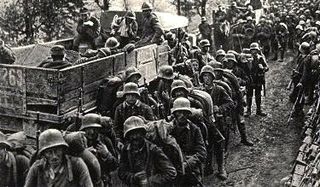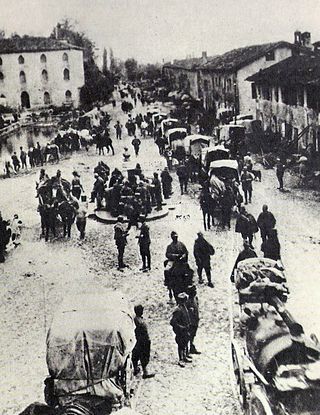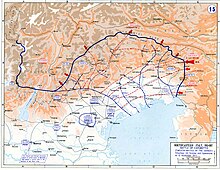
Otto Ernst Vinzent Leo von Below served as a Prussian general officer in the Imperial German Army during the First World War (1914–1918). He arguably became most notable for his command, along with the Austro-Hungarian commander Svetozar Borojević, during the victorious Battle of Caporetto in October–November 1917.
The Alpenkorps was a provisional mountain formation of division size formed by the Imperial German Army during World War I. It was considered by the Allies to be one of the best in the German Army.
The 1st Royal Bavarian Division was a unit of the Royal Bavarian Army that served alongside the Prussian Army as part of the Imperial German Army. The division was formed on November 27, 1815, as the Infantry Division of the Munich General Command. It was called the 1st Army Division between 1822 and 1848, again between 1851 and 1859, and again from 1869 to 1872. It was called the 1st Infantry Division from 1848 to 1851 and was named the Munich General Command from 1859 to 1869. From April 1, 1872, until mobilization for World War I, it was the 1st Division. Within Bavaria, it was not generally referred to as a "Royal Bavarian" division, but outside Bavaria, this designation was used for it, and other Bavarian units, to distinguish them from similarly numbered Prussian units. The division was headquartered in Munich from 1815 to 1919. The division was part of the 1st Royal Bavarian Army Corps.
The 3rd Division was a unit of the Prussian/German Army. It was formed in Stettin in May 1816 as a Troop Brigade (Truppen-Brigade). It became the 3rd Division on September 5, 1818. From the corps' formation in 1820, the division was subordinated in peacetime to the II Army Corps. The 3rd Division was disbanded in 1919 during the demobilization of the German Army after World War I.
The 28th Division was a unit of the Prussian and German Army, almost entirely made up of troops from the Grand Duchy of Baden. It was formed in Karlsruhe on 1 July 1871. The division was subordinated in peacetime to the XIV Army Corps. The 28th Division was disbanded in 1919 during the demobilization of the German Army after World War I.

The 12th Division was a unit of the Prussian/German Army. It was formed in Neiße on September 5, 1818. The division was subordinated in peacetime to the VI Army Corps. The division was disbanded in 1919 during the demobilization of the German Army after World War I. The division was recruited primarily in the Province of Silesia, mainly in the region of Upper Silesia.

The XIV Army Corps / XIV AK was a corps level command of the German Army before and during World War I. It was, effectively, also the army of the Grand Duchy of Baden, which, in 1871, had been integrated into the Prussian Army command structure, as had the armies of most German states. Both divisions and the bulk of the corps' support units were from the grand duchy. The corps was established in 1870, after the Siege of Strasbourg.
The 48th Reserve Division was a unit of the Imperial German Army in World War I. The division was formed in September 1914 and organized over the next month, arriving in the line in October. It was part of the first wave of new divisions formed at the outset of World War I, which were numbered the 43rd through 54th Reserve Divisions. The division was part of XXIV Reserve Corps. It was disbanded in 1919 during the demobilization of the German Army after World War I.

The XXVI Reserve Corps was a corps-level command of the German army during World War I.

The VII Reserve Corps was a corps level command of the German Army in World War I.

The X Reserve Corps was a corps level command of the German Army in World War I.

The VIII Reserve Corps was a corps level command of the German Army in World War I.

The V Reserve Corps was a corps level command of the German Army in World War I.

The VI Reserve Corps was a corps level command of the German Army in World War I.

The I Royal Bavarian Reserve Corps / I Bavarian RK was a corps level command of the Royal Bavarian Army, part of the Imperial German Army, in World War I.

The XIV Reserve Corps was a corps level command of the German Army in World War I.

The I Reserve Corps was a corps level command of the German Army in World War I.

The IX Reserve Corps was a corps level command of the German Army in World War I.

The Battle of Caporetto, took place from 24 October to 19 November 1917, near the town of Kobarid, on the Austro-Italian front of World War I. The battle was named after the Italian name of the town of Kobarid.

The 51st Corps was a corps formation of the German Army in World War I. It was formed in September 1916 and was still in existence at the end of the war.





